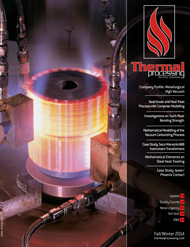Heat treating is similar to art in many ways, but not for the reasons you might think. Art, it’s said, is in the eye of the beholder—some like expressionism while others prefer representational. Likewise, new heat treating technology may be very attractive for some and absolutely rejected by others. Such is the life of those who push the envelope and strive to develop new heat treating processes—not for the sake of doing it, but to solve a problem. Induction, LPC (low pressure carburizing), HPGQ (high pressure gas quenching), and advancements in nitriding are a few that come to mind. Each process does solve a problem, but to date none have attracted overwhelming interest, except limited use by some for LPC and HPGQ in the auto industry.
Those interested in how new technology is accepted have developed a graph shown in %%0914_HS_Fig1%%. It breaks down by percentage the interest in any innovation. The smallest group on the curve, 2.5%, will embrace any new technology. Early adopters at 13.5% are those who shown proof of the benefit will purchase the technology. The largest percentage at 68% is shared equally by two groups—they are the early and late majority. These people will jump on the bandwagon so they’re not left behind. Laggards at 16% will have to be dragged kicking and screaming to adopt any new technology no matter the benefit.
The new technology I speak of here is called Intensive Quenching—trade marked as IntensiQuench™—offered by IQ Technologies, Akron, Ohio. About 50 years ago, Dr. Nikolai Kobasko of the Ukraine discovered the “intensive quenching” phenomenon. Intensive quenching can be defined as cooling, usually with pure water at a velocity several times higher than the rate of “normal” or conventional quenching. In contrast to conventional heat-treating practices, intensive quenching calls for very high cooling rates for parts within the martensite phase. Dr. Kobasko’s research shows that fast and uniform part cooling actually reduces the probability of part cracking and distortion, while improving the surface hardness and durability of steel parts.
Like vacuum carburizing, intensive quenching has been around for decades with tests being conducted proving its value by elevating the properties of plain carbon steels to match that of higher and more expensive alloy steels. Also not unlike LPC (low pressure carburizing), IQ is searching for that largest market, the early and late majority users in the heat treating industry. But also very much like LPC, IQ needs a process partner or associated process that can provide the “perfect marriage” that LPC enjoys with HPGQ. In my view, LPC has enhanced the acceptance of HPGQ and, likewise, HPGQ has moved LPC into the main stream of heat treating (although the cost for both is still a barrier to acceptance by the early and late adopters). So what will be the mutual admiration process for IQ? Time will tell. But for now, let me share a few of my observations resulting from my discussions with the principles of IQ Technologies and my experience with carburizing and quenching.
How does IQ work? Per the published information, intensive quenching consists of two forms—large batch loads racked in fixtures and trays; and a single part positioned within a vertical or horizontal quench chamber (sometime just a tube), with extremely high velocity water passing over the part. The water velocities are dramatically different for each arrangement; about five to six feet per second (1.5 to 1.8 meters per second) for the large batch load and 15 to 20 fps (4.5 to 6 mps) for single part quenching. Since a large load footprint will require enormous quantities of water, too large for practical use, and too large for the same uniformity as in the single part quench chamber, generally parts must have simple shapes, such as punches, shafts, and the like. Large gears might also be considered if racked to allow adequate water flow over each gear. It’s critical that the water velocity be high enough to prevent vapor (steam) from forming, difficult when parts are not properly racked one above the other.
In traditional oil quenching and low velocity water systems, three cooling phases have been identified; immediately when the parts are submerged in the fluid, a slower cooling vapor barrier is produced. Second a very fast nucleate boiling period, and finally a slower but more uniform convection heat transfer phase. HPGQ and IQ produce the last phase, convection heat transfer. HPGQ provides reduced distortion because it produces a very uniform convection heat transfer environment; single-part-processing via IQ due to very high water velocity does the same but provides magnitudes higher heat transfer that far exceeds anything else on the market, liquid or gas. The batch IQ quench equally eliminates the slow cooling vapor film stage characterized by very non-uniform cooling, and progresses directly to a much more uniform and faster nucleate boiling stage of quenching.
Distortion resulting from quenching steel or ferrous materials can be reduced by the following:
- Press quenching in oil, [high heat transfer with mechanical restriction]
- Salt quenching, [high heat transfer with interrupted cooling, no vapor barrier]
- HPGQ, [moderate heat transfer, convection, with interrupted cooling]
- Intensive quenching, [extremely high heat transfer with interrupted cooling, no vapor barrier]
For decades and for some is still in use, liquid salt is the best method employing interrupted quenching. High speed tools would be heated in high temperature salt to about 2200°F (1204°C) then quickly transferred into a salt bath at a temperature just above the Ms (martensite start) then allowed to cool naturally in air. This process is used universally to reduce distortion in steel.
The IQ process employs a similar interrupted quench. However, it occurs at a time when the current compressive stresses in the part surface layer reach their maximum value. These compressive stresses diminish somewhat during cooling in air (following the high speed quench) due to the phase transformation in the part core, but they always remain highly compressive. The time when surface compressive stresses are at their maximum value during the quench depends on the part shape, dimensions and type of steel, and is determined by IQ Technologies’ proprietary computer program.
An example of IQ’s effect on a heavy truck pinion is shown in %%0914_HS_Fig2%%.
Part II of intensive quench’s history will be continued in the next Thermal Processing for Gear Solutions.




























